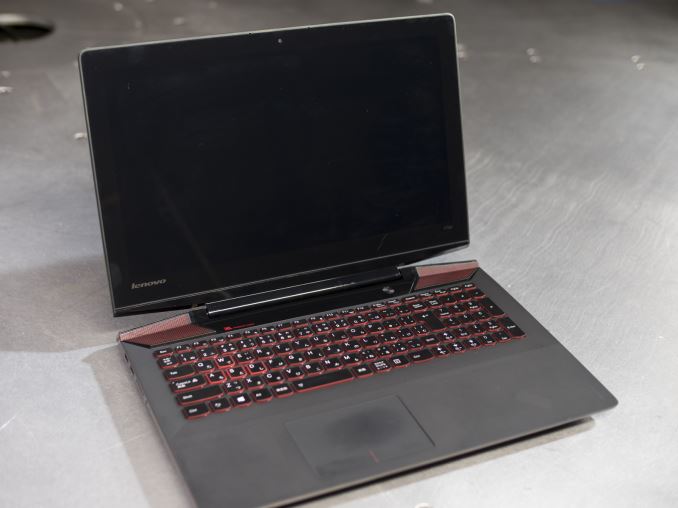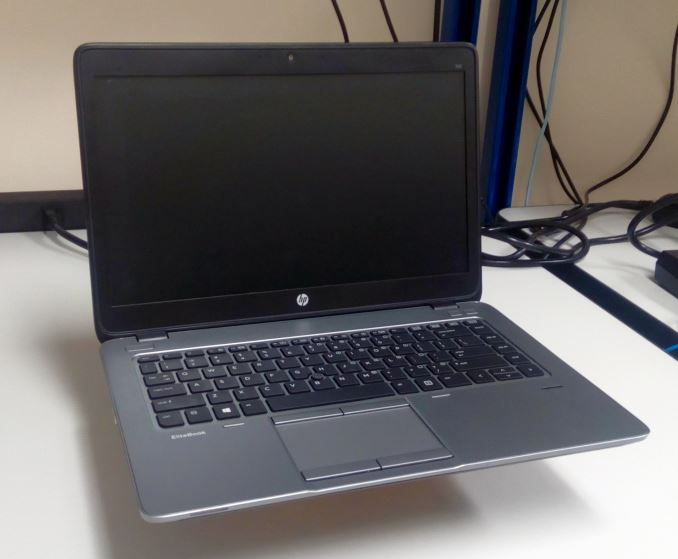Who Controls the User Experience? AMD’s Carrizo Thoroughly Tested
by Ian Cutress on February 4, 2016 8:00 AM EST
In Q2 of 2015, AMD officially launched Carrizo, their new APU aimed at mobile devices such as laptops and portable all-in-ones that normally accommodate 15W-35W processors. Quoted in the media as 'the biggest change to Bulldozer since Bulldozer itself', the marketing arm of AMD released information regarding the Excavator architecture of the new processor, and which contained a long list of fluid and dynamic implementations on improving the Bulldozer based architecture over the previous iteration of Steamroller (Kaveri). Despite this, AMDs target market for the Carrizo platform has not been receptive to AMDs product stack in recent generations due to issues surrounding performance, battery life and designs. AMD believes to have solved the first two of those matters with Carrizo, whereas the third is out of their hands and up to the OEMs to embrace AMDs platform. We wondered if the OEM’s concerns were well placed, and organized some special testing to confirm AMD’s claims about Carrizo.
Who Controls the User Experience: AMD’s Carrizo Tested
Back in early 2015, we performed a long analysis on Intel’s Core M platform, featuring 4.5W processors under the Broadwell microarchitecture. The purpose of that piece was to test several designs using that line of processors, and examining how the design of the chassis and features of the platform directly affected both performance and user experience. For Brett and I at the time, it was an eye opening endeavor, showing just how the slowest processor in a stack in the right notebook chassis can outperform the fastest, most expensive processor in a bad chassis that is wholly un-optimized.
This review is along similar lines, but instead we are testing AMD’s latest Carrizo platform, which is focused on 15W mobile parts in the $400 to $700 market. We approached AMD after the Carrizo Tech Day back in May with a proposal – to speak to engineers and to test the claims made about the platform. Typically sourcing AMD laptops, at least over the past few years, has been a veritable minefield as they are seemingly never promoted by OEM partners as review samples, or as one senior member put it, ‘Some sales people only seem to offer AMD devices if people specifically ask for them’. Our proposal involved sourcing a number of Carrizo laptops when they were launched and tackling them head on, to see how many of the claims made on the Tech Day were testable but also noticeable and true. The issue AMD and OEMs have is that everyone in the AMD-to-OEM-to-retailer chain is invested in selling the platform, so there needs to be a source of third-party testing for people who don’t trust that chain.
Over the course of a few months, our proposal changed and merged with ideas to speak with AMD’s VPs and engineers, with a number of meetings and discussions. It emerged the best way to do this was to fly to AMD’s HQ in Austin, Texas for a week and get hands on time in the labs. We agreed, as speaking to engineers and learning what is going on behind the scenes at AMD is always a good thing, but on the condition that we were free to setup, test and report without any predisposition to the results. There is an added benefit of having engineers only a floor or two away if a problem was to arise. There have been similar events in the past where media have been invited on-site for canned testing, but we made sure this wasn’t going to be the case before we arrived. For example, Qualcomm has invited select media to in-hand, temporary Snapdragon testing on a couple of occasions, with media free to test and report whatever results.
The Testing
We had four Carrizo devices on hand to test for a week, along with a single Kaveri system. These devices were sourced by AMD, and I put in requests for a variety of price points, hardware configurations and styles, along with some specific testing equipment to which we don’t have access. While it wasn’t possible to get everything on hand due to timing issues, the arrangement at least captured a number of areas we planned on testing.
The testing aimed to cover the devices as units, the underlying hardware, as well as the Tech Day claims. Some of this piece will read like a regular review, some of it similar to our Core M testing regarding performance, power and temperature, but a large part is reserved for discussing both the results and the market. When building a platform like Carrizo, a lot of binary decisions are made that can be good or bad for the processor manufacturer, the OEM or the user. We discuss these in detail as a result of our findings.












175 Comments
View All Comments
alexruiz - Friday, February 5, 2016 - link
Ian,What specific model of the Elitebook 745 G3 did you test?
You listed the QHD screen (2560 x 1440 IPS) but you also wrote that it came in at just under $700. Is this correct? The one that you received for $700 included the QHD screen?
Thanks
Anonymous Blowhard - Friday, February 5, 2016 - link
The link on the page goes to the T3L35UT#ABA, which is a 1080p screen. I'm guessing the spreadsheet and/or pricing is incorrect somehow.Ian Cutress - Friday, February 5, 2016 - link
I remember being told it was 700, though I may have misheard and perhaps they were speaking GBP. But AB is right, the larger screen is 1080p and more expensive.The HP website is surprising though - the UX on the website is crazy to find a product that isn't the latest and greatest. It is very difficult to find anything and you seem to pay a premium for speccing out a custom Elitebook. Trying to spec out the one I was given came to $1900 from a $1620 base, which clearly isn't right because the high end 'buy now' model was about $1120 with similar specifications.
http://goo.gl/5spQls
Anonymous Blowhard - Friday, February 5, 2016 - link
GBP certainly makes a lot more sense. The base USD$750 model on HP's site has an A8-8600B, 4GB of RAM, and a 500GB HDD. If you want to find a Carrizo system with an "awful user experience" there it is.Custom-building an HP business system from their site is also expensive for no reason other than "because we said so." They really want you to buy the mass-manufactured SmartBuy models, although you may have better luck with a custom unit (read: "reasonable pricing") if you buy from a 3rd-party reseller.
I would like to see some GPU benchmarks with a second stick of RAM added to the 745 G3 though. Single-channel memory gives integrated graphics the Tonya Harding treatment.
Intel999 - Sunday, February 7, 2016 - link
Another review of Carrizo in the HP 745 G3 showed a 30% improvement in gaming when the second stick of RAM was installed. It went from woefully behind Intel to just ahead of them after sufficient RAM was provided.It is remarkable that any OEM would damage their own reputation by putting out crap that is obviously intended to funnel sales to Intel.
Imagine an OEM putting out a model, let's call it HP100, and offering it with identical specs with the only difference being a Carrizo CPU vs. an I5 from Intel. Few if any, would notice a difference in performance in the real world, not talking benchmarks.
The OEM would have a $100 savings on the Carrizo version if not more. If they were to sell it for $50 less than the Intel version they would sell more and that extra $50 profit on the AMD machine would more than offset the "rebates" they are getting from Intel. So they could have a higher profit margin at a lower price point. Afterall, with all the Intel marketing you'd still have plenty of people opting for the Intel version with it's lower profit margin. Just not as many and overtime you could approach Intel and point out that you make more money off AMD machines and who knows, maybe for the first time in recent history the OEM would control how their company is run and Intel would say "I guess we can cut our price by $25" and then you would be making the same profit on both Intel and AMD machines since, of course, the OEM wouldn't pass that $25 to the customer.
They could still offer junk machines at lower price points. Fill em up with Celerons or whatever they wanted attached to HDDs, 4GB of RAM, and crap screens.
Surely, no OEM is still following the old Intel rebate plan that allowed Intel to determine the market share that the OEM is allowed to give AMD. Or, are they?
Lolimaster - Friday, February 5, 2016 - link
I hate HP store with all my might, back in the day I got better experience donwloading from japanese p2p's not knowing japanese and just using a simple guide.keeepcool - Friday, February 5, 2016 - link
Please, just dont let Toshiba make laptops, just DON'T.Sorry for the word, but Toshiba is a shit brand that deserves to die. All their laptops have cooling solutions that are badly designed from the start, and the they cut all the corners and go for paper thin 4mm heatpipes on top of deformed and pitted 1.5mm cooper plates that make poor contact with the dies, the fans are thin, the thermal paste is worse than toothpaste, just stop allowing them to disgrace AMD name.
HP is also guilty of this, after the disgrace that where the dv6 models almost no one in Portugal and a lot other countries ever want a laptop with AMD cpu or gpu, because DV6's are just know for being litteral toasters that crash and burned, yes part of that was due to lack of maintenance, but still, it left a very sour taste regard AMD/ATI equiped laptops.
Today only people with low monetary margins will go for an AMD laptop, because they are the cheapest ones, and even then HP and Toshibas just manage to make toasters out of 7 and 15Watts TDP, its like they actually spend time engineering them to became so hot with so little TDP's...
tipoo - Friday, February 5, 2016 - link
50.27 Wh, 3 cell Li-Po design, rated to 10.25 hours. Out of a 3.3GHz AMD APU.You know, HP, somehow, I don't believe you.
bluevaping - Friday, February 5, 2016 - link
Nice article. And I get the point of the article about OEM's and AMD. I mostly agree with Shadowmaster 625. But it would have been nice to see a dual channel memory test. The Elitebook supports it. Slap in the extra ram and test it. And try dual channel 1866 Ram too.tipoo - Friday, February 5, 2016 - link
Shame the Lenovo doesn't support dual graphics - any reason why, or will this be updated in drivers? Especially as the integrated one has the same number of SPs as the dedicated, it could add a lot to the power equation.